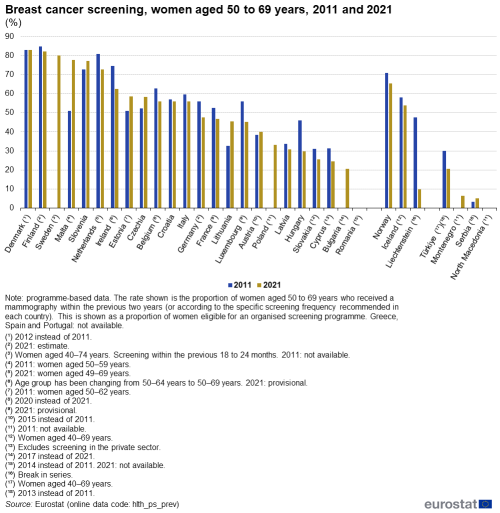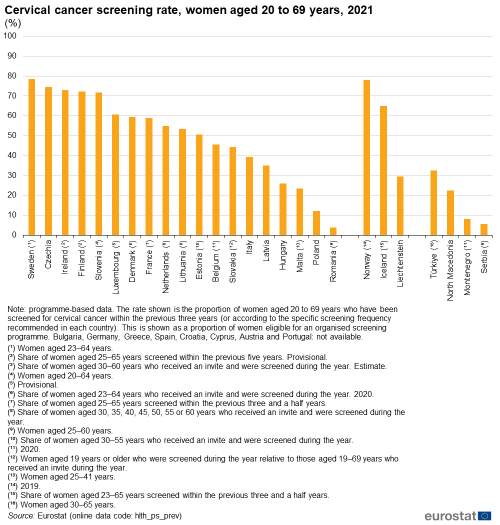Cancer screening statistics
Data extracted in July 2023.
Planned article update: 23 July 2024.
Highlights
In 2021, at least 80 % of women aged 50 to 69 years in Denmark, Finland and Sweden had been screened for breast cancer (using a mammography) within the previous two years.
In 2021, around three quarters of women aged 20 to 69 years in Sweden and Czechia had been screened for cervical cancer within the previous three years.
In 2021, close to four fifths of people aged 50 to 74 years in Finland had been screened for colorectal cancer within the previous two years.

(%)
Source: Eurostat (hlth_ps_prev)
This article presents an overview of European Union (EU) statistics related to cancer screening.
This article is one of a set of statistical articles concerning healthcare activities in the EU which forms part of an online publication on health statistics.
While most data in this article relate to 2019, the data from screening programmes are generally for 2021. As such, this article includes data that may have been impacted by the COVID-19 pandemic and its related restrictions. For this reason, particular attention should be paid when comparing the 2021 data with data from earlier years.
In some EU Member States, healthcare resources were placed under intense pressure (particularly at the start of the pandemic) from an influx of patients with COVID-19. The pandemic also resulted in a range of knock-on effects including, among others, some services being curtailed/postponed due to the number of COVID-19 patients, staff shortages within hospitals and day care centres due to infection/quarantine procedures, and patients being hindered accessing medical services due to their own infection/quarantine as well as lockdown or travel restrictions.
Full article
Breast cancer screening
The indicator covering breast cancer screening as presented in Figure 1 is defined in line with the 2003 Council Recommendation on cancer screening (2003/878/EC).
The information presented for breast cancer screening is administrative data from screening programmes. The standard analysis is the proportion of women aged 50–69 years who had received a mammography within the previous two years; in practice, some countries use different age ranges. Overall, the rates for breast cancer screening across EU Member States are somewhat higher than those reported for cervical cancer screening (see Figure 5) and much greater than those for colorectal cancer screening (see Figure 8).
Data on breast cancer screening rates are available for 2021 for 23 of the EU Member States (2020 data for Belgium and 2017 data for Bulgaria); see Figure 1 for footnotes, in particular concerning the age coverage. Among these, screening rates were below 40.0 % in six Member States, with a low of 20.6 % in Bulgaria (2017 data). Denmark, Finland and Sweden reported screening rates that were four fifths or higher, while Malta and Slovenia also had rates that were above three quarters.
A comparison of data for the two years shown in Figure 1 indicates that breast cancer screening rates increased in 6 of the 19 EU Member States for which data are available. The largest increases (in percentage point terms) were observed in Malta (up 26.9 points; note that the age range changed over time) and Lithuania (up 12.9 points). In the 13 Member States where screening rates fell between the two years shown, the decreases were generally less than 10.0 percentage points. Larger decreases were observed in Luxembourg, Ireland (note that the age range changed over time) and Hungary.

(%)
Source: Eurostat (hlth_ps_prev)
Cervical cancer screening
The indicator covering cervical cancer screening as presented in Figure 5 is defined in line with the 2003 Council Recommendation on cancer screening. It concerns the population of women aged 20–69 years having been screened for cervical cancer within the previous three years (or according to the specific screening frequency recommended in each country). The data presented are administrative data from cervical cancer screening programmes.
Data are available for 19 of the EU Member States, although the latest year, age coverage and screening frequency vary for several Member States – see Figure 5 for more details. Among these, cervical cancer screening rates peaked at close to four fifths (78.5 %) in Sweden and nearly reached three quarters (74.5 %) in Czechia. At the other end of the range, the proportion of women who had been screened for cervical cancer was 12.1 % in Poland and 3.9 % in Romania.

(%)
Source: Eurostat (hlth_ps_prev)
Colorectal cancer screening
Administrative data on colorectal screening are also from screening programmes and are presented in Figure 8. The indicators covering colorectal screening are also defined in line with the 2003 Council Recommendation on cancer screening. Data on colorectal cancer screening rates are available for 2021 for 16 of the EU Member States (2019 data for Germany). Among these, screening rates were above 50.0 % in five Member States, reaching 70.6 % in the Netherlands and 79.4 % in Finland. Rates below 20.0 % were observed in Latvia (18.8 %), Germany (15.0 %; 2019 data) and Hungary (2.8 %).

(%)
Source: Eurostat (hlth_ps_prev)
Source data for tables and graphs
Data sources
This article presents data on preventive services from two main sources of data: the first relies on screening programme data whereas the other is based on self-reported information from population surveys.
Healthcare resources and activities
Statistics on healthcare resources and healthcare activities (such as cancer screening) are documented in the background article Healthcare non-expenditure statistics – methodology which provides information on the scope of the data, its legal basis, the methodology employed, as well as related concepts and definitions.
Programme data
Breast cancer screening rates show the proportion of women (eligible for screening) that have been screened. This is based on the number of women aged 50–69 years who had received a bilateral mammography within the two years prior to the reference date (or according to the specific screening frequency recommended in each country) as a share of women eligible for an organised screening programme.
Cervical cancer screening rates show the proportion of women (eligible for screening) that have been screened. This is based on the number of women aged 20–69 years who have been screened for cervical cancer within the three years prior to the reference date (or according to the specific screening frequency recommended in each country) as a share of women eligible for an organised screening programme.
Colorectal cancer screening rates show the proportion of people (eligible for screening) that have been screened. This is based on the number of people women aged 50–74 years who have been screened for cervical cancer within the two years prior to the reference date (or according to the specific screening frequency recommended in each country) as a share of people eligible for an organised screening programme.
For country specific notes on these data collections, please refer to the annexes at the end of the national metadata reports accessible from links at the beginning of the European metadata report.
The Healthcare non-expenditure statistics manual provides an overview of the classifications, both for mandatory variables and variables provided on voluntary basis.
Health status
Self-reported statistics covering the health status of the population – including X-ray breast examinations, cervical smear tests and screening for colorectal cancer – are provided by the European health interview survey (EHIS). This source is documented in more detail in the background article European health interview survey – methodology which provides information on the scope of the data, its legal basis, the methodology employed, as well as related concepts and definitions.
Context
Primary prevention offers the most cost-effective, long-term strategy for reducing the burden of diseases across the EU. It involves tackling major health determinants (see Chapter 3), such as smoking, unhealthy diets and physical inactivity. The European Commission has supported many projects related to health determinants and health promotion in general.
Secondary prevention aims to reduce mortality by early detection, for example, the detection of cancer through screening.
- In December 2003, a Council Recommendation on cancer screening (2003/878/EC) was adopted, setting out principles of best practice. This invited EU Member States to take common action to implement national population-based screening programmes for breast, cervical and colorectal cancer, with appropriate quality assurance at all levels.
- In 2014, the European Commission released a report on the implementation of the 2009 Communication on action against cancer: European partnership and the second implementation report on the 2003 Council Recommendation.
- A proposal to update the 2003 Recommendation to reflect the latest available scientific advice was adopted by the European Commission in September 2022 and in December 2022, the Council of the European Union adopted a new approach on cancer screening. This aims to improve early detection throughout the EU.
- This new approach is a key element of the EU supported cancer screening scheme. The scheme is one of the flagship initiatives of the Europe’s Beating Cancer Plan, a key pillar of a stronger European Health Union.
Indicators on breast, cervical and colorectal cancer screenings are included in the health services chapter of the European core health indicators (ECHI).
Direct access to
Online publications
Health status – selected diseases and related health problems
Healthcare activities
Methodology
General health statistics articles
- Health (hlth), see:
- Health care (hlth_care)
- Preventive services (hlth_prev)
- Self-reported last breast examination by X-ray among women by age and educational attainment level (hlth_ehis_pa7e)
- Self-reported last cervical smear test among women by age and educational attainment level (hlth_ehis_pa8e)
- Self-reported last colorectal cancer screening test by sex, age and educational attainment level (hlth_ehis_pa5e)
- Preventive cancer screenings - programme data (hlth_ps_prev)
- Preventive services (hlth_prev)
Atlas
News releases
- Healthcare non-expenditure statistics (ESMS metadata file – hlth_res)
- European health interview survey (ESMS metadata file – hlth_det_esms)